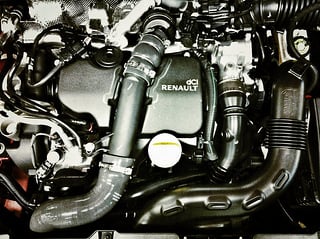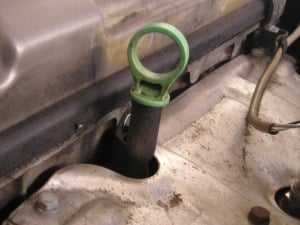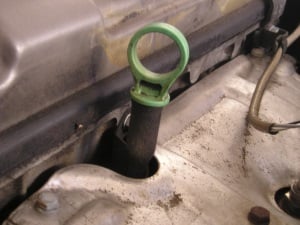When Is Engine Oil Consumption Considered Excessive? James on Engines #6
Bell Performance's master mechanic James Dunst gets more than a few questions from the automotive public on aspects of lubricating oil. What's the...

 If you suspect that there’s an internal problem that’s leading to a loss of power/performance, you would take the vehicle to a mechanic. Once there, there are certain things that must be done prior to replacing parts or performing service. You have to know what the problem is before you can know how to fix it.
If you suspect that there’s an internal problem that’s leading to a loss of power/performance, you would take the vehicle to a mechanic. Once there, there are certain things that must be done prior to replacing parts or performing service. You have to know what the problem is before you can know how to fix it.
If you have a 1981 or newer vehicle, it will most likely have an engine management computer. The computer monitors functions of a number of engine compartment components. When a problem develops in a system that is monitored by the computer, codes which relate to the particular system will be set and retained in computer memory. When this happens, the check engine light on the dash will illuminate. If the light stays on continuously this is called a hard fault – this is the easiest problem to find because the problem is there, right now. If the light comes on and goes out, the fault is intermittent, meaning the problem was there momentarily but has cleared up. Both of these conditions will set computer codes that are retained by the computer.
In most vehicles, these diagnostic codes will remain in memory for fifty engine warmup cycles. If the problem does not reoccur, the codes will be erased by the computer (it doesn’t need to retain them because the problem was resolved). Steer clear of a mechanic or shop that replaces parts without doing the proper diagnostics first. Checking for computer codes first is important because it may lead you directly to the cause of the power & performance problem, saving time and money.
There are a number of electronic sensors and components located in your vehicles engine compartment that can have a big effect on your vehicle’s power and performance. One item is the Oxygen Sensor - the sensor the computer uses to know what the air/fuel ratio is so it can make the proper fuel to air adjustments. In this area, the main mission of the engine computer is to maintain the correct air/fuel ratio. If this sensor malfunctions, it can cause idling problems and drivability problems like engine surge, jerking or stalling.
The other item that has a major effect on performance is the Throttle Position Sensor. This sensor tells the computer the position of the throttle or gas pedal. Some vehicles no longer have throttle cables, instead using drive-by-wire technology to increase or decrease a vehicles speed.
Problems in either of these items usually set computer codes in the computer which turns on the check engine light on your dash. If you suspect that either one of these components could be defective, they should be diagnosed by a professional with the proper diagnostic equipment. How fuel can affect power and performance issues
Most of the gasoline sold today contains 10% percent ethanol. This is the amount the gasoline is supposed to have in it, but many times the percentage is higher. This can be caused by error or even intentional cheating because ethanol is cheaper than gasoline. Ethanol has 25% less energy than gasoline, so the more ethanol you have in your fuel the less power, performance and fuel mileage you will have.
It is also important to know what fuel your vehicle requires. If it says use premium fuel on the dash or the fuel fill door, that is what you need to use. Higher compression engines require higher octane fuel to prevent pre-ignition. If you put 87 octane in a 1981 or newer vehicle the computer will pick up the pre-ignition using a knock sensor on the engine block. The computer will then retard (change) the ignition timing to eliminate the pre-ignition. That solves that problem, but along with it, your power, performance and good fuel mileage are reduced. So that’s the down side.
If you have a diesel vehicle, you may have a cetane issue with your fuel. Technically, cetane is a specific kind of molecule that can be found in diesel fuel, but in this context, cetane is shorthand for cetane index – a measure of how well the fuel ignites and burns in the combustion chamber. Think of it as the diesel equivalent of octane.
All diesel engines have a fuel cetane rating they are designed to operate best at, so if your diesel fuel cetane level is lower than what the engine was designed for, you will have less power because the diesel fuel won’t be fully combusting at the proper time it’s supposed to. Black smoke while driving is a good indicator that the cetane level is low. To fix the problem, cetane boosters can be purchased to raise the level in the fuel. But keep in mind that if your existing fuel cetane rating is adequate for your engine, then using a cetane improver to boost it even higher isn’t really going to do anything for you.
Proper ignition timing is absolutely essential to ensuring that your vehicle gets the best power and performance. That’s why, on newer vehicles, the computer monitors and controls the timing. The down side is that, with computers, the ignition timing cannot be manually adjusted.
It is possible to have a problem with the computer but this condition is rare and would have to be diagnosed by a professional with the proper equipment. Now, if you have an older vehicle with adjustable ignition timing, it is one of the first things that should be checked and adjusted if found to be out of specification.
If the engine seems to bog down on acceleration or under load, it could be that the fuel filter is restricted with trash from the fuel system. This blocks the flow of fuel to the fuel injector rail. Fuel filters on modern vehicles should be changed every 25,000 miles. It is important to note that fuel filter restrictions do not come and go. Once they are restricted, they will not get better or suddenly become unplugged. At this point, they must be replaced. Luckily, it’s one of the most minor and simple jobs on the vehicle (many people can do it themselves). If your problem is intermittent, then it most likely has nothing to do with the fuel filter.
A restricted exhaust system can have an enormous effect on power and performance. If you listen to the exhaust coming out the tail pipe and it has an airy sound to it, this is a good indication that something is not right with the exhaust system and there is a possible restriction.
The main symptom of a restricted exhaust is an extreme lack of power under heavy acceleration or when attempting to climb a hill. There are two ways to verify this condition. The first is to attach a vacuum test gauge to a port on the intake manifold. Holding the RPM at a steady 2000, you should see steady readings around 15 to 18 inches of vacuum. If you see the vacuum gauge dropping close to zero, this indicates the exhaust is backing up into the engine.
If you do not have a vacuum gauge and have a car that is air conditioned, there is another test you can perform. Heating systems in most vehicles are designed to revert to defrost if there is a loss of vacuum. This is done for safety purposes so that in a cold climate you will have the defrost mode to keep the windshield clean if there is a loss of vacuum in the heating system. Turn on the air conditioning so it is blowing out the dash. Find yourself a good sized hill and accelerate so the engine is under a load. If the exhaust system is restricted, the vacuum in the intake manifold will drop and the air conditioning will switch from the dash to the defrost vents. When you let off the accelerator, it will switch back to the dash.

Bell Performance's master mechanic James Dunst gets more than a few questions from the automotive public on aspects of lubricating oil. What's the...
One of the dirty little secrets in the engine lubricant industry is that sometimes a synthetic oil isn't really synthetic. This is news to consumers...

Through the Contact Us forms on the Bell website, we get all kinds of inquiries about fuel problems and engines from the general public. Some of them...